 Any boat seems to be sturdy and durable when you buy it, but if you do not give it the care it deserves and needs, it’s going to be unusable quite soon. Rust, grime, stains of dirt, water spots, and that’s far from all. Can you fix that? Of course, you can. Sand, polish, and wax, and your boat is as good as new. However, that takes time, and it also quires to spend a considerable amount of money on polishes, waxes, other compounds, and tools.
Any boat seems to be sturdy and durable when you buy it, but if you do not give it the care it deserves and needs, it’s going to be unusable quite soon. Rust, grime, stains of dirt, water spots, and that’s far from all. Can you fix that? Of course, you can. Sand, polish, and wax, and your boat is as good as new. However, that takes time, and it also quires to spend a considerable amount of money on polishes, waxes, other compounds, and tools.
Waxing protects the boat from all of that, but the wax itself also degenerates slowly when exposed to the sun, water, and wind. You can’t help it when you’re out in the sea, the wax coat is your first line of defense. But if you’re storing or transporting your boat, you can also use a boat cover for extra protection.
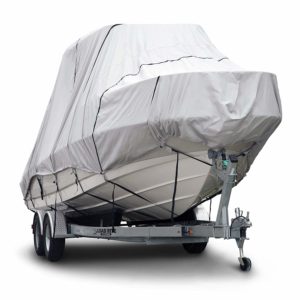
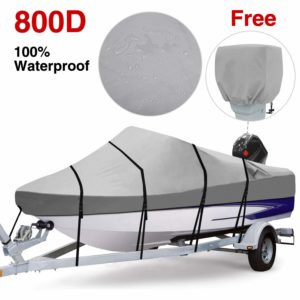
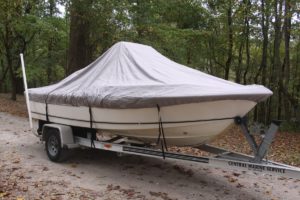
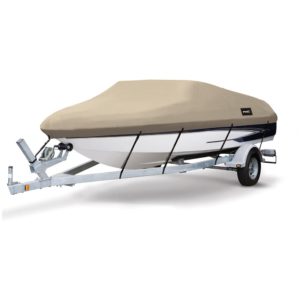
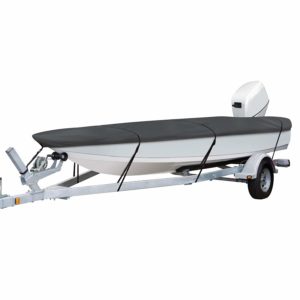
Top 5 Best Boat Coverss in 2019
1Budge B-620-X6 Boat Cover — Best T-Top Boat Cover
If you have a hard top boat, this boat cover is the only way to go. It was specially designed to fit T-Top boats, and no typical V-Hull cover is going to cover such a boat unless it’s oversized.
But not this cover. Granted, it’s a little too much for a typical motorboat, but for a T-Top, it’s probably the best option on the market.
I’ve not tried covering bimini top with this boat cover, but it should work, in theory. Don’t take it at face value, though.
The fabric has a density of 600 deniers. While it’s definitely nothing to write home about, it’s pretty decent, and these days, it’s something of an industry standard anyway.
The cover is made from PE, which is both water resistant and breathable. It’s UV-treated to ensure even better protection of the boat. As for rain or snow, they no longer are a concern as long as you have put this cover on your boat.
- Breathable. It’s a decent breathable PE cover that can easily prevent condensation.
- Sewn-in trailering straps. You don’t have to worry about the straps sliding off when in transit. They are actually sewn into the cover.
- T-Top. The only decent boat cover for a T-Top I’ve seen in a long time.
- UV treated. Extra UV protection can never hurt.
- Expensive. I get it, T-Top covers are hard to come by, but this is a little over the top.
2RVMasking Boat Cover — Best for Transportation
If you really want to get a heavy duty boat cover, forget about 600D fabrics. Yes, they are pretty durable, and that’s good, but they aren’t heavy duty, not when other, more dense fabrics are available and actually utilized in boat cover production.
This RVMasking boat cover is made from 800D PE, and that, my dear audience, is a game changer. This is what you call a durable boat cover. It is perfect for transportation because it can protect your boat from more than just an occasional bug hitting it at full speed. Even if you hit a small piece of wood, it’s not going to tear through, while it can be quite stressful for a 600D boat cover.
The cover is UV-protected, reinforced, and waterproofed. The fabric is not very breathable, but it’s compensated for with the built-in vents. Still, I can’t help but think they compromise the cover’s overall strength.
- Dense. The boat cover is exceptionally dense, and it's great for any situation where you might need a heavy duty boat cover.
- Reinforced. Aside from utilizing dense fabrics, the boat cover is additionally reinforced with double stitches and triple protection in the corners.
- UV treated. An extra layer of UV protection.
- Motor Cover included. A free extra. What's not to appreciate?
- Vents for breathability. While I'm happy that this boat cover is breathable, that breathability is achieved thanks to the vent, which weaken the cover's integrity.
3VORTEX HEAVY DUTY CONSOLE BOAT COVER — Best for Mooring
This Vortex boat cover is perfect for mooring. But it doesn’t mean you can’t use it for storage or transporting the boat because you can.
Since it’s canvas, it offers decent durability even at 600D, and the polyurethane lining adds to the waterproofing. The drawstring allows a better fit, but don’t worry, you can always get a different size if your boat is smaller or larger than this boat cover.
I couldn’t find any mention of UV treatment, but canvas is quite good at shielding things from UV anyway.
- Canvas. Canvas is an excellent material for a boat cover because of its natural density.
- Mooring boat cover. While I’ve been careful to choose only those boat cover that could be used for mooring, this one is better than average.
- Drawstring. Nothing significant, but it's nice to have.
- Does not look cool. Frankly, I’m struggling to think of any real disadvantage, and this is definitely not it. But it does look very simple.
4MSC Boat Cover — Best Bang for the Buck
It’s essential to buy a decent boat cover. It’s also important to save some money in the process. Is there a way to combine these two things? Yes, you can get this MSC heavy duty boat cover. Not that I would call it really heavy-duty compared to some other products, but it’s not weak, it’s made from canvas, and that’s enough for me.
The thing I like best about this boat cover is that it’s Tri-Hull compatible, as well as V-Hull. The storage bag is just a nice bonus, I wouldn’t say no to free stuff. Still, it’s probably included in the price anyway.
The boat cover performs best with a boat cover support pole system, but the cover does not come with one.
- Canvas. Makes the cover suitable for moored boats.
- Cheap. Usually, looking for the most affordable option on the market is not the way to go. But if it's cheap and good, why not choose it over the alternatives?
- Tri-Hull. If you need that, here it is.
- Carry bag included. Quite thoughtful of the manufacturer, but don’t let this affect your opinion.
- Not quite water resistant. You won’t like it if water pockets on top of the cover.
- Support pole not included. This boat cover performs best with a support pole, but it’s not included.
5Classic Accessories StormPro Boat Cover — Best Tri-Hull & V-Hull
This is a nice V-Hull and Tri-Hull compatible boat cover, and, unfortunately, it’s not really good for mooring. You can use it for that purpose, but I can promise any results. But it’s great for storage and travel thanks to the elastic hem, so there’s that.
Anything I can say about this boat cover has been said at one point or another. It’s Made of polyester, and while it’s waterproof and breathable, it’s not as good as canvas strength-wise.
However, this boat cover has a massive advantage over many. It’s a support pole cover, but unlike other boat covers of this kind, it comes with a support pole included, as it should be.
- Elastic hem. Makes it easier to secure the boat for travel.
- Support Pole Included. It’s designed for support pole, and you don’t have to buy it separately.
- Tri-Hull. Not the best fit, but it’s possible to cover a Tri-Hull boat with this cover.
- Not suitable for mooring. You can still use it that way, but it’s better not.
